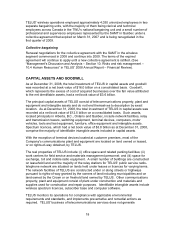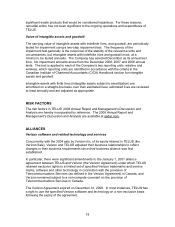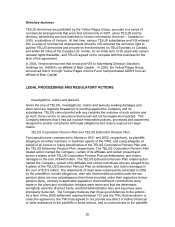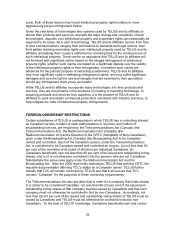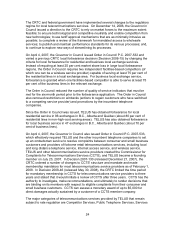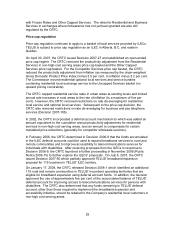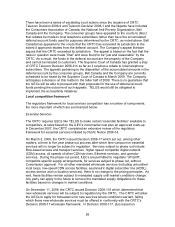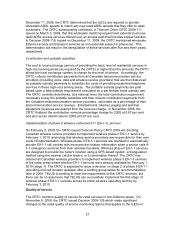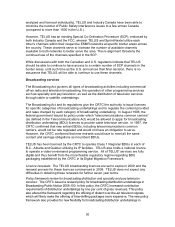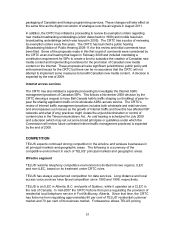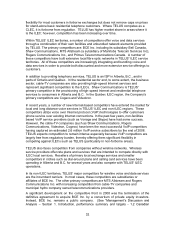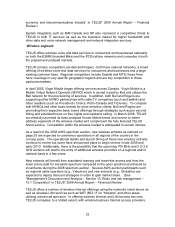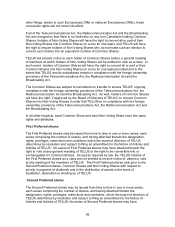Telus 2008 Annual Report Download - page 27
Download and view the complete annual report
Please find page 27 of the 2008 Telus annual report below. You can navigate through the pages in the report by either clicking on the pages listed below, or by using the keyword search tool below to find specific information within the annual report.December 11, 2008, the CRTC determined that the ILECs are required to provide
wholesale ADSL speeds to match any new retail ADSL speeds that they offer to retail
customers. The CRTC subsequently confirmed, in Telecom Order CRTC 2009-111
issued on March 3, 2009, that this wholesale matching requirement extends to all new
retail ADSL access services offered over an access path that includes copper facilities.
In Decision 2008-118, issued on December 11, 2008, the CRTC maintained wholesale
Ethernet access and transport services as non-essential subject to phase-out. This
determination will result in the deregulation of these services after five and three years,
respectively.
Contribution and portable subsidies
The cost to local exchange carriers of providing the basic level of residential services in
high-cost serving areas (as required by the CRTC) is higher than the amounts the CRTC
allows the local exchange carriers to charge for the level of service. Accordingly, the
CRTC collects contribution payments from all Canadian telecommunication service
providers (including voice, data and wireless service providers) that are then disbursed
as portable subsidy payments to subsidize the costs of providing residential telephone
services in these high-cost serving areas. The portable subsidy payments are paid
based upon a total subsidy requirement calculated on a per line/per band subsidy rate.
The CRTC currently determines, at a national level, the total contribution requirement
necessary to pay the portable subsidies and then collects contribution payments from
the Canadian telecommunication service providers, calculated as a percentage of their
telecommunication service revenue. Entertainment, Internet, paging and terminal
equipment revenues are exempt from the revenue charge. In November 2008, the
CRTC finalized the contribution revenue percentage charge for 2008 at 0.87 per cent
and also set an interim rate for 2009 at 0.87 per cent.
Implementation of phase II wireless enhanced 911 (E9-1-1) services
On February 2, 2009, the CRTC issued Telecom Policy CRTC 2009-40, directing
Canadian wireless service providers to implement wireless phase II E9-1-1 service by
February 1, 2010, and ruling that wireless service providers are responsible for their own
costs of implementation. Wireless phase II E9-1-1 services are intended to automatically
provide E9-1-1 call centres with more precise location information when a person calls 9-
1-1 emergency services from their wireless handsets. Wireless phase II E9-1-1 services
are designed to provide the caller's location using a GPS-based system, a triangulation
method using the nearest cellular towers, or a combination thereof. The CRTC has
ordered all Canadian wireless providers to implement wireless phase II E9-1-1 services
in the same areas where wireline E9-1-1 services were already available by February 1,
2010 (stage 1). The CRTC is expected to issue a decision on stage 2 of phase II E9-1-1
(providing mid-call location updates) after a working group tables its recommendations
later in 2009. TELUS is working to meet the requirements of this CRTC decision, but
there can be no assurance that TELUS can successfully implement the first stage of
wireless phase II E9-1-1 services across its entire wireless operating territory by
February 1, 2010.
Quality of service
The CRTC monitors quality of service for retail services in non-forborne areas. On
November 8, 2008, the CRTC issued Decision 2008-105 which made significant
changes to the retail quality of service monitoring regime that applies to the ILECs in
27



